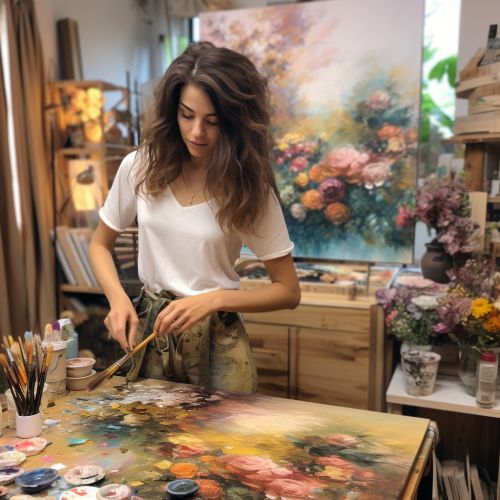Visual Arts
Overview
Visual arts are a broad category of art forms that include mediums such as painting, sculpture, printmaking, photography, and other visual media. These art forms are primarily visual in nature, using elements such as line, color, shape, texture, and form to create aesthetic value. The term "visual arts" is often used to distinguish these art forms from other types of art, such as performing arts, literary arts, or culinary arts.
History
The history of visual arts is vast and varied, spanning thousands of years and encompassing a wide range of cultures and civilizations. The earliest known visual art forms date back to prehistoric times, with cave paintings and carvings serving as some of the earliest examples. These early works often depicted animals and human figures, and were likely used for ritualistic or symbolic purposes.
As civilizations developed, so too did the complexity and sophistication of visual arts. In ancient Egypt, for example, visual arts played a significant role in religious and political life. Artists created elaborate wall paintings and sculptures to decorate tombs and temples, using a strict set of conventions to represent the human figure and the natural world.
In ancient Greece and Rome, artists began to move away from these rigid conventions, experimenting with more realistic representations of the human figure and the natural world. This period also saw the development of new art forms, such as mosaic and fresco painting.
The Middle Ages brought about significant changes in the visual arts, with the rise of Christianity influencing much of the art of this period. Artists often created works with religious themes, using symbolic imagery to convey spiritual messages.
The Renaissance marked a major turning point in the history of visual arts, with artists like Leonardo da Vinci, Michelangelo, and Raphael pushing the boundaries of artistic expression. They experimented with perspective, light and shadow, and the human form, creating works that are still celebrated today for their technical skill and artistic innovation.
The modern era has seen an explosion of new art movements, from Impressionism and Cubism to Abstract Expressionism and Pop Art. These movements have challenged traditional notions of what art can be, expanding the possibilities for artistic expression.
Types of Visual Arts
There are many different types of visual arts, each with its own unique characteristics and techniques. Some of the most common types include:
Painting


Painting is one of the oldest and most well-known forms of visual art. It involves applying pigment to a surface, such as canvas or paper, to create an image or design. There are many different styles and techniques of painting, from the realistic depictions of the Renaissance to the abstract compositions of the 20th century.
Sculpture
Sculpture involves creating three-dimensional works of art by carving, modeling, or assembling materials. Sculptors may work with a variety of materials, including stone, wood, clay, metal, and glass.
Printmaking
Printmaking involves creating artworks by printing, typically on paper. Printmaking techniques include etching, lithography, screenprinting, and woodcut.
Photography
Photography is a relatively recent addition to the visual arts, having been invented in the 19th century. It involves capturing images with a camera, either using film or digital technology.
Other Visual Media
Other forms of visual arts include ceramics, textiles, jewelry, furniture design, and digital art. These art forms often combine elements of other visual arts, such as painting and sculpture, with unique techniques and materials.
Importance of Visual Arts
Visual arts play a crucial role in society, serving both functional and aesthetic purposes. They can convey ideas and emotions, provoke thought, and stimulate cultural understanding. Visual arts can also serve practical purposes, such as design in architecture, fashion, and industrial design.
Visual arts contribute to personal development, helping individuals to express their creativity, improve their observational skills, and gain a deeper appreciation for the world around them. They also play a vital role in education, helping students to develop critical thinking skills, improve their problem-solving abilities, and enhance their cultural literacy.
In the cultural sphere, visual arts help to preserve and communicate cultural heritage, reflect societal values, and provoke critical dialogue. They also contribute to the economy, through the sale of artworks, the operation of galleries and museums, and the provision of arts-related services.
